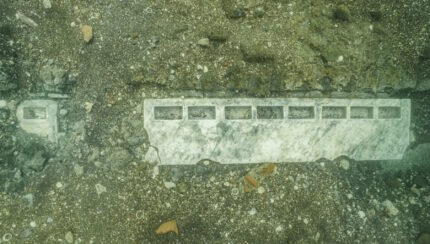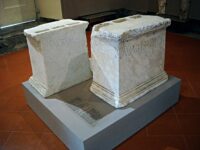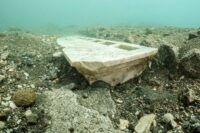The remains of two altars from a Nabatean temple have been discovered on the seabed of Pozzuoli in southern Italy, the now-submerged heart of the ancient commercial port of Puteoli. The altars date to the first half of the 1st century A.D. and are similar to the larger, more complete great altar discovered in the same area by fishermen in 1965. The base of that altar bears the inscription DVSARI SACRVM, or “sacred to Dusares,” (aka Dushara) the head deity of the Nabatean pantheon and unique to the Nabatean religion.
The slots in the top of the altar slabs are votive niches that originally held betyls, sacred stones venerated as effigies of the gods. Traditional Nabatean religion was aniconic, meaning there were no figural representations of the gods. Instead, the gods were represented by cultic stelae/standing stones. A later colossal bust of Dushara was discovered in Pozzuoli and is now in the Vatican Museums. By this time his image had become fully Romano-Hellenized, so he was fully figural. As the head of the Nabatean pantheon, he was identified with Zeus and depicted as a man with a thick curly beard.
 These finds bring the total number of Nabatean altar slabs and altar bases found in this area of sunken city to five since the first was discovered in the 18th century. (The first three — two bases and one slab — are now in the collections of the National Archaeological Museum of Naples and the Archaeological Park of Campi Flegrei at the Castle of Baiae.)
These finds bring the total number of Nabatean altar slabs and altar bases found in this area of sunken city to five since the first was discovered in the 18th century. (The first three — two bases and one slab — are now in the collections of the National Archaeological Museum of Naples and the Archaeological Park of Campi Flegrei at the Castle of Baiae.)
Founded as a Greek colony in 531 B.C., Puteoli was made a Roman colony in 195 B.C. and became Rome’s principal port at the center of the Mediterranean traffic in goods — wine, Tyrian purple, textiles, perfumes, jewels, etc — from and to Europe, the Levant and the Near East. Between the 1st century B.C. and the 1st century A.D., the merchants of Puteoli spread out far and wide in the Mediterranean world, establishing trade relations with local populations and securing lucrative contracts. The foreign producers and traders who traveled to Puteoli eventually formed permanent communities there with their own homes, shops, temples and cemeteries.
 The Nabateans, an Arab people whose territory at its apex in the 1st century B.C. stretched from the Euphrates to the Red Sea, controlled trade routes conveying luxury goods from the Indian Ocean and the Far East to the Arabian peninsula and southern Levant. The magnificent rock-cut capital of Petra in modern-day Jordan was the last stop of caravans on the lucrative spice and perfume routes before the goods were shipped overseas to Europe from the Port of Gaza. The kingdom became a vassal state of Rome in the 1st century B.C., albeit still very much independent, and was absorbed into the Roman empire by Trajan in 106 A.D.
The Nabateans, an Arab people whose territory at its apex in the 1st century B.C. stretched from the Euphrates to the Red Sea, controlled trade routes conveying luxury goods from the Indian Ocean and the Far East to the Arabian peninsula and southern Levant. The magnificent rock-cut capital of Petra in modern-day Jordan was the last stop of caravans on the lucrative spice and perfume routes before the goods were shipped overseas to Europe from the Port of Gaza. The kingdom became a vassal state of Rome in the 1st century B.C., albeit still very much independent, and was absorbed into the Roman empire by Trajan in 106 A.D.
Their trade interests put the Nabateans in business with Puteoli, which by the 1st century was the largest commercial port on the Mediterranean. The Nabatean community settled in the Vicus Lartidianus, the suburban neighborhood on the southern edge of Puteoli where the foreign merchants lived and transacted their business.
While the presence of the Nabatean temple was known from the discovery of the altars, its exact location, position and dimensions were not. The recent discovery of the altars and a new topographical survey have allowed researchers to pinpoint the precise position of the temple, as well as warehouses, imperial administration buildings and roads of the ancient port.